Nikon Coolpix 5900
Review Date: April 18th 2005
|
Image Quality
All of the sample images in this Review were taken using the 5M Fine file quality setting, which gives an average image size of around 1.5Mb.
Noise
There are 4 ISO settings available on the Nikon Coolpix 5900 which you can select at any time. Here are some 100% crops which show the noise levels for each ISO setting:
ISO 64 (100% crop) |
ISO 100 (100% crop) |
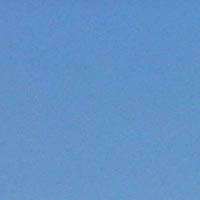 |
 |
ISO 200 (100% crop) |
ISO 400 (100% crop) |
 |
 |
The noise levels look excellent across most of the available ISO range, with ISOs 64-200 showing little noise., Some noise is starting to appear at the fastest setting of ISO 400 but it is still perfectly usable. A very good performance by the Nikon Coolpix 5900's 5 megapixel CCD sensor.
Sharpening
You can set the sharpening in-camera to one of four different settings (Hard, Normal, Low, Off) or leave it on Auto and allow the camera to decide. Here are two 100% crops which have been Saved as Web - Quality 50 in Photoshop. The right-hand image has had some sharpening applied in Photoshop. The out-of-the camera images at the setting of Normal are quite soft, with post-processing showing quite a lot of extra detail.
Original 100% Crop |
Sharpened 100% Crop |
 |
 |
 |
 |
File Quality
The Nikon Coolpix 5900 has 3 different file quality settings - Fine, Normal and Basic - which are available for all of the 5 image sizes. Rather than show you all 15 possible combinations, here are some 100% crops which show the quality of the 5M image size at the 3 quality settings, with the file size shown in brackets.
|
Fine (2592 x 1944px) (1.51Mb) |
Normal (2592 x 1944px) (870.4Kb) |
 |
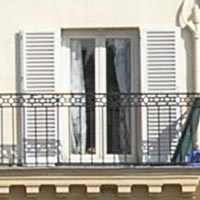 |
|
Basic (2592 x 1944px) (591.3Kb) |
|
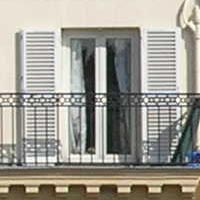 |
|
Chromatic Aberrations
I had to look extremely hard to find any examples of chromatic aberrations in the review shots taken with the Nikon Coolpix 5900, and in the end I could only find one example! You can see a faint purple-fringing around the edges of the building against the very high-contrast sky, but it's not too obvious at all. A fantastic performance by the Nikon Coolpix 5900.
|
Example 1 |
|
 |
|
Macro
The Nikon Coolpix 5900 has a Macro setting that allows you to focus on a subject that is 4cms away from the camera. The first image shows how close you can get to the subject (in this case a compact flash card). The second image is a 100% crop.
|
Macro Shot (click to view full-sized image) |
100% Crop |
Flash
The flash options on the Nikon Coolpix 5900 are Auto, Red-eye Reduction Auto (In-Camera Red-Eye Fix), Anytime Flash, Flash Cancel and Slow sync. These shots of a white wall were taken at a distance of 1.5m.
|
Flash Off - Wide Angle (38mm) |
Auto Flash - Wide Angle (38mm) |
 |
 |
|
Flash Off - Telephoto (114mm) |
Auto Flash - Telephoto (114mm) |
 |
 |
And here are some shots of yours truly. The flash underexposed the scene very slightly. Both the Flash On and Red-eye Reduction (with Nikon's new Advanced Red-eye Reduction) flash modes produced no discernible redeye.
|
Flash On |
Flash On (100% Crop) |
 |
 |
|
Flash - Red-Eye Reduction |
Flash - Red-Eye Reduction (100% Crop) |
 |
 |
Night Shot
The Nikon Coolpix 5900's maximum shutter speed is only 4 seconds which isn't that great if you're seriously interested in night photography. The following example was taken using the Night scene mode, which used a shutter speed of 1/5th second with an aperture of f/2.8 at ISO 200 and noise reduction turned on. I've included a 100% crop of the image to show what the quality is like.
|
Night Shot (click to view full-sized image) |
100% Crop |
 |
|
D-Lighting
D-Lighting is similar to HP's Adaptive Lighting technology, in that it lightens under-exposed parts of the image whilst ensuring that correctly exposed parts remain the same (and are not also lightened). This basically balances the shadows and highlights in a high-contrast image, for example a scene that includes deep black shadows and a bright white sky. D-Lighting is selected by pressing the OK button when an image is played back, so it is applied after the image has been recorded. The Nikon Coolpix 5900 processes a copy of the image (which takes around 15 seconds) so that some areas of the photograph are lightened and some are left as they are. Here are some examples which show the effects of using the D-Lighting feature, showing that it works well, although there is extra noise in the images that have had D-Lighting applied to them:
|
D-Lighting - Off |
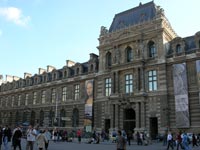 |
| D-Lighting - On |
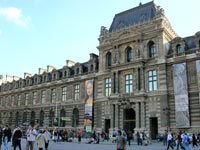 |
|
D-Lighting - Off |
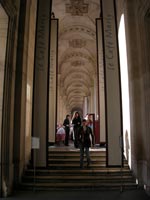 |
| D-Lighting - On |
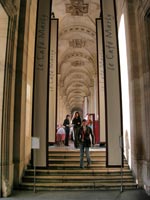 |
|
D-Lighting - Off |
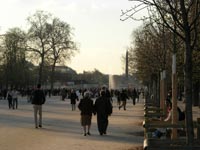 |
| D-Lighting - On |
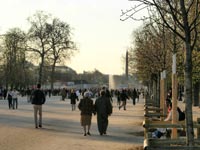 |
Overall Image Quality
The Nikon Coolpix 5900 produced a very good set of test images. The 5 megapixel photos are quite soft out of the camera at the default setting of Normal and benefit from further sharpening in an application like Adobe Photoshop. Alternatively you can select the Hard sharpening setting on the camera. Noise was very well controlled at all ISO settings, with only ISO 400 really showing visible noise. The Nikon Coolpix 5900 dealt brilliantly with chromatic aberrations, which only appeared in one image and even then was barely noticeable. Macro performance was good, allowing you get as close as 4 cms away from your subject. The new D-Lighting feature works very well with the right images, balancing out the shadow and highlight areas nicely, although it does introduce extra noise. The Nikon Coolpix 5900's flash had a tendency to underexpose slightly indoors but there was no evidence of redeye in any of the test shots. Night-shots are limited due to the 4 second maximum shutter speed.
|
 PhotographyBLOG is a member of the DIWA organisation. Our test results for the Nikon Coolpix 5900 have been submitted to DIWA for comparison with test results for different samples of the same camera model supplied by other DIWA member sites.
PhotographyBLOG is a member of the DIWA organisation. Our test results for the Nikon Coolpix 5900 have been submitted to DIWA for comparison with test results for different samples of the same camera model supplied by other DIWA member sites.



